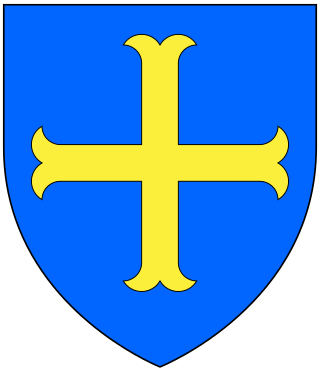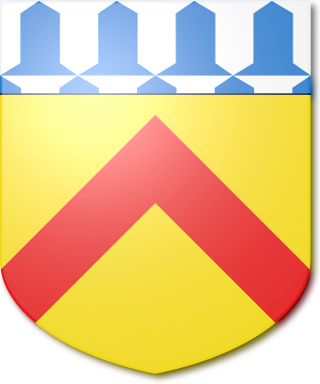Sir Richard Willis, 1st Baronet was a Royalist officer during the English Civil War, and a double agent working for the Parliamentarians during the Interregnum.

The Ernle Baronetcy, of Etchilhampton in the County of Wiltshire, was a title in the Baronetage of England. It was created on 2 February 1661 for Walter Ernle, later Member of Parliament for Devizes. He died on 25 July 1682, and was buried at Bishops Cannings, Wiltshire. He was succeeded by his grandson, Sir Walter Ernle (1672–1690), 2nd Baronet, of Maddington, Wiltshire, who was, in turn, succeeded at his own death by his younger brother, Sir Edward Ernle (1673–1728/9), 3rd Baronet, P.C., MP. The third Baronet was succeeded by a kinsman, Sir Walter Ernle (1676–1732), 4th Baronet, of Conock, in the parish of Chirton, Wiltshire, who died childless, and was succeeded by his younger brother, the Reverend Sir John Ernle, 5th Baronet, Rector of All Cannings, Wiltshire, who was predeceased by his only son.

There have been six baronetcies created for persons with the surname Smyth, two in the Baronetage of England, one in the Baronetage of Great Britain, one in the Baronetage of Ireland and two in the Baronetage of the United Kingdom. One creation is extant as of 2010.

Three baronetcies have been created in the Baronetage of England for members of the Littleton or Lyttelton family. All three lines are descended from Thomas de Littleton, a noted 15th-century jurist. Despite differences in the spelling of the title, the names of all three lines were spelt in many varied ways in the early modern period, without distinction between the different branches of the family. This can be confusing, as the range of forenames in use was very limited.

The Baronetcy of Hartopp of Freathby was created in on 3 December 1619 in the Baronetage of England for Edmund Hartopp, High Sheriff of Leicestershire 1618–9. He represented the parliamentary constituency of Leicestershire 1628–9. His grandson, the third Baronet represented the county 1679–81. The Baronetcy became extinct in 1762 when the estates passed by the female line to Cradock-Hartopp.

There have been twenty one baronetcies created for persons with the surname Williams, eight in the Baronetage of England, three in the Baronetage of Great Britain and ten in the Baronetage of the United Kingdom. Only six of the creations are extant as of 2017.
Three baronetcies were created for persons with the surname D'Oyly, two in the Baronetage of England and one in the Baronetage of the United Kingdom. One creation is extant as of 2008.
The Worsley family is an English family that is derived from Sir Elias de Workesley, a Norman knight who was a youth at the time of the Norman conquest. He later accompanied Duke Robert II of Normandy on the First Crusade and was buried at Rhodes.
Peregrine Hoby, was an English landowner and member of parliament who sat in the House of Commons at various times between 1640 and 1679.

There have been three baronetcies created for descendants of the ancient Norman family of Molyneux who were granted extensive estates in Lancashire after the Norman Conquest.

There have been five baronetcies created for members of the old established family of Peyton of Peyton Hall in the parish of Boxford in Suffolk, all of whom were descended from Sir Robert Peyton of Isleham in Cambridgeshire, grandson and heir of Thomas Peyton (1418–1484) of Isleham, twice Sheriff of Cambridgeshire and Huntingdonshire, in 1443 and 1453. All the baronetcies are extinct.

There have been three baronetcies, all in the Baronetage of England, created for members of the Spencer family, both for descendants of two younger sons of Sir John Spencer (1524–1586) of Althorp, Northamptonshire.
There have been two Baronetcies created for persons with the surname Strachan, both in the Baronetage of Nova Scotia. Both are currently either extinct or dormant.
There have been two baronetcies created in the Baronetage of England for members of the Colepeper family of Kent and Sussex. Both are extinct.

There have been four baronetcies created for persons with the surname Cope.

The St Quintin Baronetcy, of Harpham in the County of York, was a title in the baronetage of England. It was created on 8 March 1642 for William St Quintin. The third Baronet sat as Member of Parliament for Kingston upon Hull. The fourth Baronet was Member of Parliament for Thirsk. The title became extinct on the death of the fifth Baronet in 1795. The family estate of Scampston Hall was passed on to the late Baronet's nephew, William Thomas Darby, the son of Vice-Admiral George Darby, who assumed the surname and arms of St Quintin.
Sir Thomas Willys, 1st Baronet of Fen Ditton in Cambridgeshire, was a Member of Parliament for Cambridgeshire and Cambridge. He was also Sheriff of Cambridgeshire and Huntingdonshire.
Sir John Meux, 1st Baronet was an English politician who sat in the House of Commons from 1640 to 1643. He supported the Royalist cause in the English Civil War.

Sir Thomas Biggs, 1st Baronet, was an English politician.
The Bundfamily of Wick Episcopi owned estates in Worcestershire since the fifteenth century; from this armigerous landed gentry family came several individuals of note in the fields of law, local government and literature.











